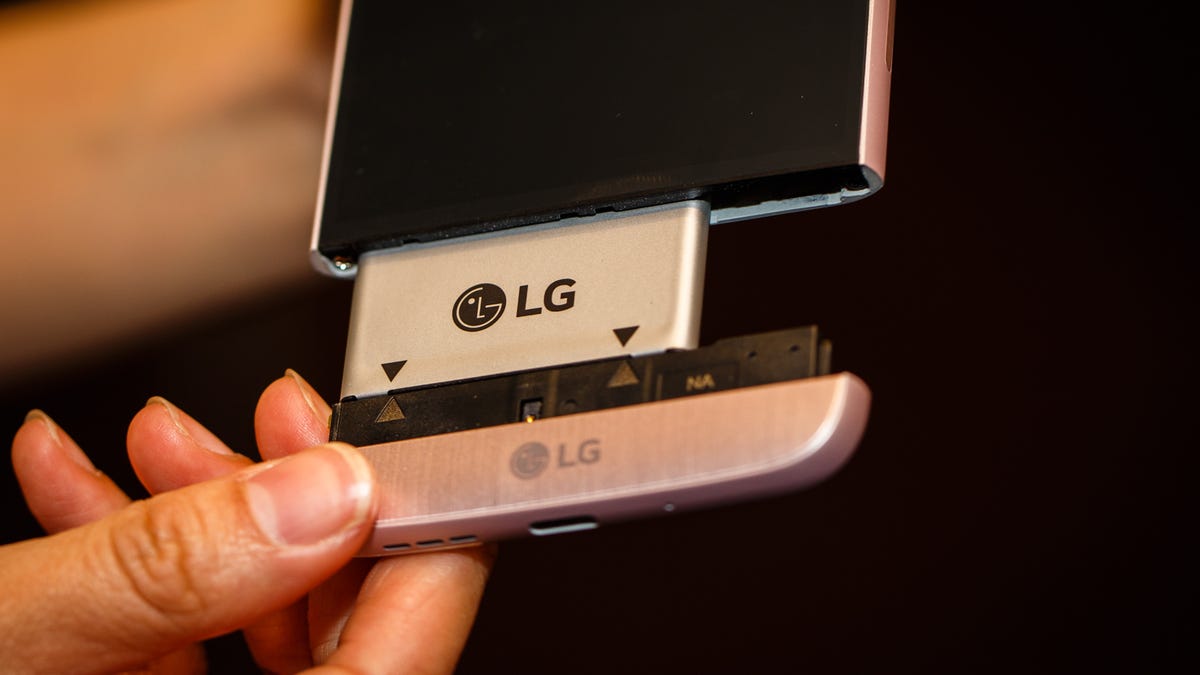A cure for phone fatigue? LG hopes uber-customizable G5 wows
LG has a grand plan to offer swappable parts to change and augment its flagship phone. One problem: There aren't many pieces right now.

LG has been feeling what we've been feeling: It's getting harder to get pumped up for a new phone.
LG's mobile president, Juno Cho, kicks off the G5 presentation.
In fact, the company has known that for a while.
On the day in November 2014 that Juno Cho took the reins of the Korean conglomerate's mobile business, he asked Ramchan Woo, who heads up the development of its flagship phones, about horsepower. After getting a list of impressive specs, Cho, according to Woo, said, "That's powerful enough. I'm just doing messaging."
The LG G5 sports an all-metal body and a camera upgrade, but the company really wants you to notice the swappable modules.
It's with that comment that LG set out in a different direction for its newest marquee smartphone, the G5. Rather than talk up processing power or memory, LG spent its Sunday press conference here in Barcelona focusing on the G5's "friends," or different modular components that can be added to change the phone's capabilities.
Removing the bottom "chin" of the G5, which holds the battery, lets you swap in replacement parts such as the CAM Plus, which adds a bulkier grip for steady shots, physical shutter and zoom buttons, and an extra battery pack. Another module is the Hi-Fi Plus, which replaces the bottom with a souped-up stereo created by Bang & Olufsen.
The customizable concept, which has been in the works for three years, represents a novel way of fighting phone fatigue, or the waning enthusiasm people feel for mobile devices. With only incremental improvements emerging out of each successive generation of phones, it's getting harder to justify an upgrade. That's illustrated by declining sales from phone stalwart Samsung Electronics and even flattening sales from Apple.
"We don't see excitement anymore," Cho said on stage at the event.
It's telling that LG is trying to stir up interest not from its phone, which offers some of the latest components and features, like a metallic body and an advanced camera, but from a collection of products designed to enhance usefulness of the device. The company hopes that customers who once enthusiastically downloaded apps to customize their phone will get passionate about tweaking their device with different hardware attachments, turning it into both a digital and physical Swiss Army knife.
"We really want to get the credit of changing the way you use a smartphone," Woo said in an interview Saturday.
It's unclear, however, whether consumers are willing to change.
"The LG G5 looks great on its own, and it's going to have to sell that way -- consumers don't buy modular products," tweeted Avi Greengart, who covers consumer electronics for Current Analysis.
Few options to start
The focus on modules and customizing the physical device plays into the strengths of LG, which can tap into divisions like its chemicals and display businesses for different kinds of hardware attachments.
While the idea of creating an ecosystem of hardware accessories is ambitious, it's unclear how many of these attachments will actually emerge. The camera grip and audio attachment are slated to debut with the launch of the phone in early April, and LG teased another module with physical controls that lets you fly a Parrot drone. It also showed off a virtual reality camera and headset, although they don't attach to the G5.
The LG Cam Plus adds a large grip, physical camera controls and an extra battery.
LG hinted at more to come, with Cho calling it a new "playground" for its "friends."
Woo confirmed that he expects to have nearly one new "friend" each month for the next several months, built by partners or by LG itself.
As with apps, the number of modules will depend on interested third-party manufacturers. The challenge will be selling enough phones to convince companies to build attachments for the G5. In the last quarter, LG sold 15.3 million phones. By comparison, Apple sold 75 million iPhones in the same holiday period.
To drum up support, Woo met with a number of smaller manufacturers, including those that use crowd-funding sites such as Kickstarter. LG will introduce a plan next month to provide support to manufacturers to build different modules, he said. Software tools and guidance will follow.
LG plans to commit to this modular concept in future devices, Woo said, so this isn't a one-off.
"This is our direction," he said.
But will anyone notice?
LG took a big risk holding a splashy launch event at the Mobile World Congress show in Barcelona just hours before Samsung is set to hold its own press conference. LG's past phones, which have taken chances with features like a rear button and a curved display, have often gotten lost in the shuffle with the attention on Samsung's latest Galaxy S phone.
Woo promised a much bigger marketing campaign than in previous years, though it's unlikely the company will be able to spend as much as its deeper-pocketed Korean rival.
LG is also banking that the modular approach will help it stand apart from a crowded pack, which also includes cheaper alternative Android phones from Chinese vendors.
"The big question is, will LG's current customers be interested in these and will it attract new customers?" said Carolina Milanesi, an analyst at Kantar WorldPanel.
LG realized some time ago that making slight improvements to a design that was defined by the iPhone nearly a decade back would never allow it to break through in the market. Even if it's a wild shot, credit LG for trying something different.
"We thought we could change the way of the game," Woo said.

